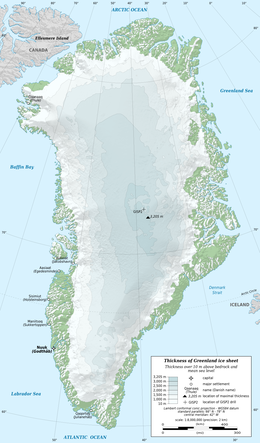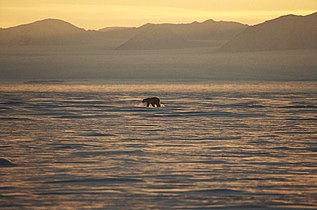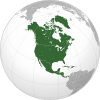|
Geography of Greenland
Greenland is located between the Arctic Ocean and the North Atlantic Ocean, northeast of Canada and northwest of Iceland. The territory comprises the island of Greenland—the largest island in the world—and more than a hundred other smaller islands (see alphabetic list). Greenland has a 1.2-kilometer-long (0.75 mi) border with Canada on Hans Island.[1] A sparse population is confined to small settlements along certain sectors of the coast. Greenland possesses the world's second-largest ice sheet. Greenland sits atop the Greenland plate, a subplate of the North American Plate.[2][3] The Greenland craton is made up of some of the oldest rocks on the face of the earth. The Isua greenstone belt in southwestern Greenland contains the oldest known rocks on Earth, dated at 3.7–3.8 billion years old.[4] The vegetation is generally sparse, with the only patch of forested land being found in Nanortalik Municipality in the extreme south near Cape Farewell. The climate is arctic to subarctic, with cool summers and cold winters. The terrain is mostly a flat but gradually sloping icecap that covers all land except for a narrow, mountainous, barren, rocky coast. The lowest elevation is sea level and the highest elevation is the summit of Gunnbjørn Fjeld, the highest point in the Arctic at 3,694 meters (12,119 ft). The northernmost point of the island of Greenland is Cape Morris Jesup, discovered by Admiral Robert Peary in 1900. Natural resources include zinc, lead, iron ore, coal, molybdenum, gold, platinum, uranium, hydropower and fish. AreaTotal area: 2,166,086 km2 Land area: 2,166,086 km2 (410,449 km2 ice-free, 1,755,637 km2 ice-covered) Maritime claims: Territorial sea: 3 nautical miles (5.6 km; 3.5 mi) Exclusive fishing zone: 200 nautical miles (370.4 km; 230.2 mi) Land useArable land:
approximately 6%; some land is used to grow silage.
The total population comprises around 56,000 inhabitants, of whom approximately 18,000 live in the capital, Nuuk. Natural hazardsContinuous ice sheet covers 84% of the country; the rest is permafrost. Environment – current issuesProtection of the Arctic environment, climate change, pollution of the food chain, excessive hunting[5] of endangered species (walrus, polar bears, narwhal, beluga whale and several sea birds). Climate  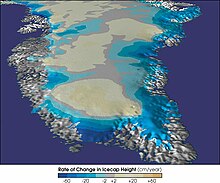 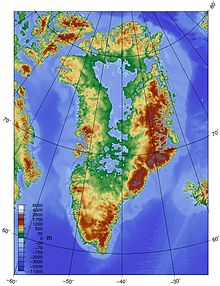 Greenland's climate is a tundra climate on and near the coasts and an ice cap climate in inland areas. It typically has short, cool summers and long, moderately cold winters. Due to Gulf Stream influences, Greenland's winter temperatures are very mild for its latitude. In Nuuk, the capital, average winter temperatures are only −9 °C (16 °F).[6] In comparison, the average winter temperatures for Iqaluit, Nunavut, Canada, are around −27 °C (−17 °F).[7] Conversely, summer temperatures are very low, with an average high around 10 °C (50 °F).[6] This is too low to sustain trees, and the land is treeless tundra. On the Greenland ice sheet, the temperature is far below freezing throughout the year,[8] and record high temperatures have peaked only slightly above freezing. The record high temperature at Summit Camp is 2.2 °C (36.0 °F).[9] In the far south of Greenland, there is a very small forest in the Qinngua Valley, due to summer temperatures being barely high enough to sustain trees. There are mountains over 1,500 metres (4,900 ft) high surrounding the valley, which protect it from cold, fast winds travelling across the ice sheet.[10] It is the only natural forest in Greenland, but is only 15 kilometres (9.3 mi) long.
Climate changeThe Greenland ice sheet is 3 kilometers (1.9 mi) thick and broad enough to blanket an area the size of Mexico. The ice is so massive that its weight presses the bedrock of Greenland below sea level and is so all-concealing that not until recently did scientists discover Greenland's Grand Canyon or the possibility that Greenland might actually be three islands.[14] If the ice melted, the interior bedrock below sea level would be covered by water. It is not clear whether this water would be at sea level or a lake above sea level. If it would be at sea level it could connect to the sea at Ilulissat Icefjord, in Baffin Bay and near Nordostrundingen, creating three large islands.[15] But it is most likely that it would be a lake with one drain. It is thought that before the last Ice Age, Greenland had mountainous edges and a lowland (and probably very dry) center which drained to the sea via one big river flowing out westwards, past where Disko Island is now.[16] There is concern about sea level rise caused by ice loss (melt and glaciers falling into the sea) on Greenland. Between 1997 and 2003 ice loss was 68–92 km3/a (16–22 cu mi/a), compared to about 60 km3/a (14 cu mi/a) for 1993/4–1998/9. Half of the increase was from higher summer melting, with the rest caused by the movements of some glaciers exceeding the speeds needed to balance upstream snow accumulation.[17] A complete loss of ice on Greenland would cause a sea level rise of as much as 6.40 meters (21.0 ft). Researchers at NASA's Jet Propulsion Laboratory and the University of Kansas reported in February 2006 that the glaciers are melting twice as fast as they were five years ago. By 2005, Greenland was beginning to lose more ice volume than anyone expected – an annual loss of up to 52 cubic miles or 217 cubic kilometres per year, according to more recent satellite gravity measurements released by JPL. The increased ice loss may be partially offset by increased snow accumulation due to increased precipitation. Between 1991 and 2006, monitoring of the weather at one location (Swiss Camp) found that the average winter temperature had risen almost 10 °F (5.6 °C). Recently, Greenland's three largest outlet glaciers have started moving faster, satellite data show. These are the Jacobshavn Isbræ at Ilulissat (Jacobshavn) on the western edge of Greenland, and the Kangerdlugssuaq and Helheim glaciers on the eastern edge of Greenland. The two latter accelerated greatly during the years 2004–2005, but returned to pre-2004 velocities in 2006.[18] The accelerating ice flow has been accompanied by a dramatic increase in seismic activity. In March 2006, researchers at Harvard University and the Lamont–Doherty Earth Observatory at Columbia University reported that the glaciers now generate swarms of earthquakes up to magnitude 5.0.[14] The retreat of Greenland's ice is revealing islands that were thought to be part of the mainland. In September 2005 Dennis Schmitt discovered an island 400 miles (644 km) north of the Arctic Circle in eastern Greenland which he named Uunartoq Qeqertaq, Inuit for "warming island".[19] Future projectionsIn the Arctic, temperatures are rising faster than anywhere else in the world. Greenland is losing 200 billion tonnes of ice per year. Research suggests that this could increase the sea levels' rise by 30 centimeters by the end of the century. These projections have the possibility of changing as satellite data only dates back to 40 years ago. This means that researchers must view old photographs of glaciers and compare them to ones taken today to determine the future of Greenland's ice.[20] Temperature extremes
Highest temperatures
Lowest temperatures
TopographyThe ice sheet covering Greenland varies significantly in elevation across the landmass, rising dramatically between the coastline at sea level and the East-Central interior, where elevations reach 3,200 meters (10,500 ft).[21] The coastlines are rocky and predominantly barren with fjords.[22] Numerous small islands spread from the Central to Southern coastlines.[22] Greenland's mountain ranges are partially or completely buried by ice. The highest mountains are in the Watkins Range, which runs along the eastern coast. Greenland's highest mountain is Gunnbjorn Fjeld with a height of 3,700 meters (12,139 ft).[22] Scientists discovered an asteroid impact crater in the northwestern region of Greenland, buried underneath the ice sheet. At a size larger than Washington, D.C., it is the first impact crater found beneath one of Earth's ice sheets.[23] Extreme pointsThis is a list of the extreme points of Greenland, the points that are farther north, south, east or west than any other location. Territory of Greenland
Mainland Greenland
TownsGreenland has 17 towns – settlements with more than 500 inhabitants. Nuuk is the largest town – and the capital – with roughly one third of the country's urban population. Sisimiut with approximately 5,500 inhabitants is the second largest town, while Ilulissat is number three with around 5,000 inhabitants.
History of explorationGallery
See also
References
External linksWikimedia Commons has media related to Geography of Greenland.
|
||||||||||||||||||||||||||||||||||||||||||||||||||||||||||||||||||||||||||||||||||||||||||||||||||||||||||||||||||||||||||||||||||||||||||||||||||||||||||||||||||||||||||||||||||||||||||||||||||||||||||||||||||||||||||||||||||||||||||||||||||||||||||||||||||||||||||||||||||||||||||||||||||||||||||||||||||||||||||||||||||||||||||||||||||||||||||||||||||||||||||||||||||||||||||||||||||||||||||||||||||||||||||||||||||||||||||||||||||||
